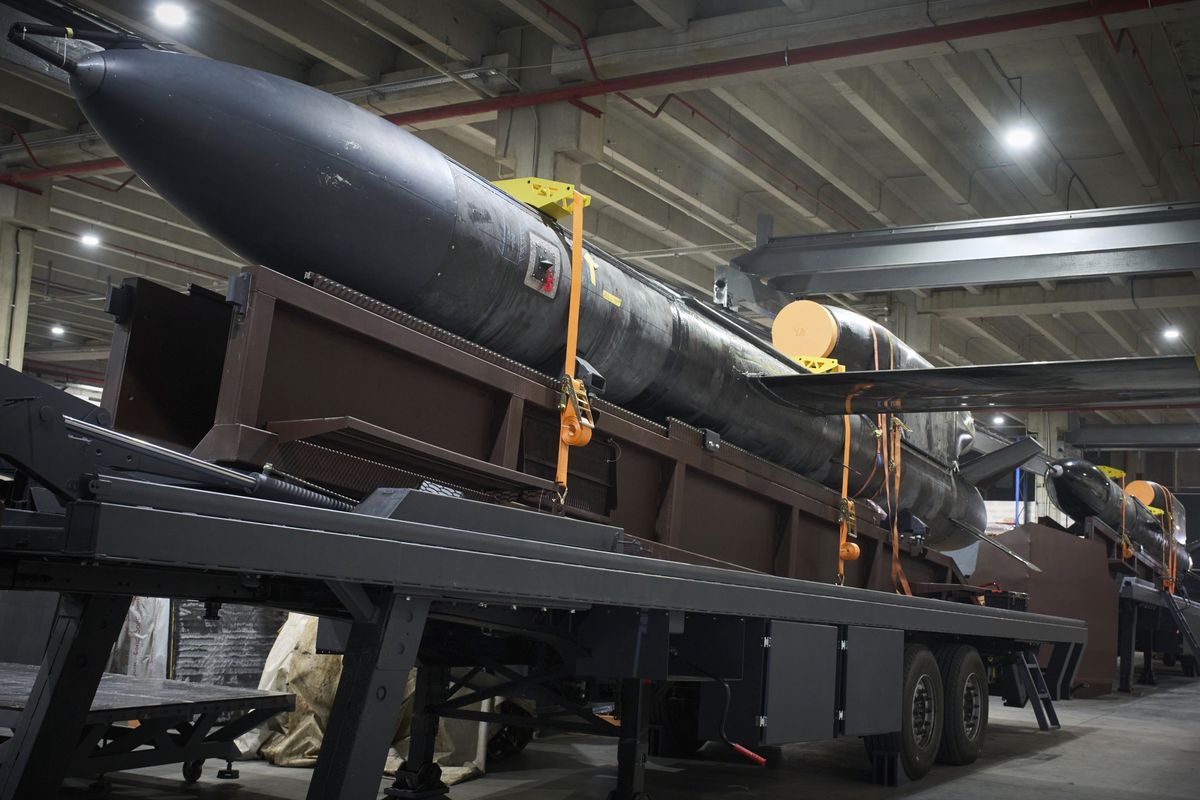DEEP DIVE — For months it was a hypothetical question: Could Ukraine continue to fight if the Trump administration ends its support? Late Monday, President Trump made it an urgent reality, temporarily suspending the delivery of all U.S. military aid to Ukraine, in the latest and most substantial blow to Ukraine's resistance against Russia.
The order came just three days after Trump's public criticism of Ukrainian President Volodymyr Zelensky in the Oval Office, and will affect more than $1 billion in American weapons that are in the aid pipeline. A White House official told news agencies that the hold on military aid would remain in place until President Trump determines that Ukraine is committed to peace negotiations with Russia. The suspension also temporarily halts hundreds of millions of dollars in U.S. aid that were provided through the Ukraine Security Assistance Initiative, which sent funds to Ukraine that had to be spent on purchases from American defense companies.
Earlier Monday, National Security Advisor Mike Waltz said that “the American people's patience is not unlimited, their wallets are not unlimited, and our stockpiles and munitions are not unlimited.”
Experts are divided as to how damaging a U.S. aid cutoff would be for the Ukrainian resistance. Some suggest an immediate crisis; others believe Ukraine could hold its own for several months. A wild card in any assessment is how quickly European nations might boost their own deliveries of aid to make up for the shortfall. But there is agreement on this much: an end to U.S. support can only be bad news for Ukraine.
“The fact of the matter is Mr. Zelensky needs Europe, but he also needs America,” Gen. Philip Breedlove, a former NATO Supreme Allied Commander for Europe, told The Cipher Brief before the suspension was announced. “And some of Europe is loath to act without America. So, he’s going to have to find his way to sit back down with the president of the United States…and work things out.”
Earlier Monday, Oleksiy Goncharenko, a member of Ukraine’s parliament, told The Cipher Brief that “Ukraine can fight without U.S. support, but the result of this will be thousands and maybe tens of thousands of lives lost, of the best Ukrainians. This scenario is a nightmare.”
The U.S. aid pipeline
Even before Monday's announcement, it had been nearly two months – dating to the last days of the Biden Administration – since the Pentagon had announced a new package of weapons.
U.S. military assistance for Ukraine kicked into high gear on February 24, 2022, the day Russia launched its full-scale invasion. The Biden administration authorized a $350 million delivery of weapons from Pentagon stockpiles. According to The New York Times, the U.S. ultimately sent another 71 shipments of aid worth $33.8 billion – deliveries that included more than three million 155-millimeter artillery shells, tens of thousands of guided artillery rockets and anti-tank missiles, thousands of antiaircraft missiles, thousands of armored vehicles and dozens of tanks.
The U.S. has also provided $33.2 billion under the Ukraine Security Assistance Initiative.
Lt. Gen. Ben Hodges, a former Commander of U.S. forces in Europe, said Monday that a cutoff of American support would be “a huge strategic mistake for the U.S. and the Trump Administration.”
He told The Cipher Brief that Ukraine’s fate was now tied to other European nations who “are rallying around President Zelensky and Ukraine,” and he expressed hope that Europe might step up and begin to make up the difference.
“If Europe can actually summon the political will to fully deliver the enormous economic and industrial potential in Europe, which dwarfs Russia's, and deliver the support to Ukraine they're capable of delivering,” Lt. Gen. Hodges said, “Ukraine will win or at least will be in a much better position.”
All eyes on Europe
That hope now hangs over Ukraine and much of Europe.
With U.S. military aid paused, the main source of military assistance for Ukraine will be the Ukraine Defense Contact Group, a collection of nearly 50 nations that was stitched together in April 2022 by then-Defense Secretary Lloyd Austin. The last time that group met at Germany’s Ramstein Air Base in January, Zelensky said it would be “crazy to drop the ball now” on aid to Ukraine, after his country had resisted Russia for nearly three years.
According to the Kiel Institute, Europe has provided $138 billion to Ukraine’s war effort over those three years; the figure for U.S. military and humanitarian aid is $119 billion.
In the last week, following the Trump administration’s pivot toward Russia and away from Ukraine, European countries have signaled increased support for Kyiv. After a meeting with Zelensky on Sunday, several countries announced plans to boost military spending and form a “coalition of the willing” to defend Ukraine.
British Prime Minister Keir Starmer said the UK will send $2 billion in air defense missiles to Ukraine and increase its domestic military spending; Friedrich Merz, whose party won this month’s election in Germany and is likely to be the next Chancellor, vowed a major boost in defense spending and called on his country and the rest of Europe to move toward “independence, step-by-step,” from the United States. And Ursula von der Leyen, President of the European Commission, said Europe must arm Ukraine to help turn the country into a “steel porcupine” — in other words, a nation too painful for Russia to attack.
“It is basically turning Ukraine into a steel porcupine that is indigestible for potential invaders,” von der Leyen said, “and making sure that over time this is a strong and resilient country.”
For Ukraine and its European supporters, the concern is that the sudden and sharp break with the U.S. will make it difficult for Europe to move quickly enough to make up the losses.
Ukrainian officials say around 20 percent of military hardware currently used by Ukraine’s armed forces is from the U.S.; roughly 25 percent comes from Europe and the remaining 55 percent is now manufactured by Ukraine itself. However, the U.S. arms are widely seen as the most effective and difficult to source from other countries.
The Guardian cited Rachel Ellehuus, the director general of the Royal United Services Institute, as saying there are three key U.S. contributions that Europe has limited capacity to replace: air defenses, long-range ballistic missiles, and satellite communications.
Meanwhile, key European nations are facing economic headwinds that will make a spike in defense spending difficult. As The Economist noted, while “Europe can afford to pay more,” many countries are scrambling to find ways to finance new arms manufacturing or deliveries – a relaxation of European Union debt rules for defense expenditures, tapping the bond markets to establish a European defense fund, and talk of a rearmament bank modeled on the European Bank for Reconstruction and Development."
One potential source of funds is the $218 billion in Russian assets that are frozen in European banks, but European leaders fear that Hungary’s President Viktor Orban – an ally of Russian President Vladimir Putin – may block efforts to tap those funds.
“This requires unanimity,” Poland's Prime Minister Donald Tusk said of the vote to keep the assets frozen. “We know what Hungary’s position is, what it may be.”
As if to lower expectations that Europe might quickly fill a gap left by the U.S., the outgoing German chancellor Olaf Scholz said Sunday that boosting military spending “will require an effort that many are not yet really sufficiently prepared for.”
Such statements have only deepened skepticism among some officials in Ukraine.
“Europe has already taken important steps and it’s promising to do more: Summits, telephone calls, draft decisions on a surge in defense spending and announcements of assistance to Ukraine are now happening at a blistering pace,” the former Ukrainian Foreign Minister Dmytro Kuleba wrote in an op-ed for the New York Times.
“As welcome as these developments are, they fail to answer the most fundamental question about the future of Ukraine and the rest of Europe: When? When will these ideas become implemented decisions?”
Battlefield realities
On the day that Trump scolded Zelensky at the White House, Russia launched more than 150 drones against Ukrainian cities. That reflected a recent jump in Russian drone attacks; in February, there were 22 days on which Russia sent 100 or more attack drones into Ukraine – double the number of such days in January. Most of those drones are shot down, but invariably, some get through.
Overall, the battlefield situation hasn’t changed much in the last several months. Russia has made incremental gains in the east, most of those at huge cost, and Russian ground advances have slowed in recent weeks. Some experts believe Putin will seek further battlefield gains before formal peace negotiations begin.
“At this point, before there is an agreement, Putin is going to do everything he can to capture as much terrain as he can,” Admiral James Stavridis, a former Supreme Allied Commander at NATO, told The Cipher Brief.
“And if you're in the business of trying to capture a little bit more terrain, what's the most valuable terrain? It's going to be those portions that have these strategic resources, be they oil, gas, big agrarian complexes, copper, lithium, cobalt, nickel, or if there are rare earths, those would be particularly valuable as well. So I think there's a macro sense, get as much land as you can. And then I think secondly, target those strategic resources.”
After Zelensky’s difficult visit to the White House, Andriy Parkhomenko, a Ukrainian soldier, told Newsweek that the episode showed that international diplomacy is now "dead" and that Ukraine will have to fight it out with Russia.
“It does not mean that Ukrainians are ready to give up our values and honor," Parkhomenko said. "We are absolutely clear that we may potentially lose on a battlefield, but we would rather die trying to save the nation.”
Read more expert-driven national security insights, perspective and analysis in The Cipher Brief because National Security is Everyone’s Business.












